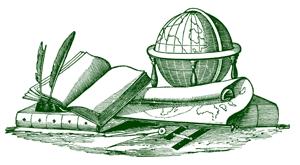| What is Place?
At first glance, location and place are not evocative terms. Location, from the Latin locus meaning “place,” becomes either absolute or relative in geographical usage. Place –– variously derived from the middle English/old French “open space,” Latin “broad street,” Greek “broad” or “flat,” and the Spanish “plaza” –– becomes invested with all manner of characteristics. Yet “place” is a useful term in geography, and much more evocative than the general public’s picture of the essence of geography –– place name location.
The chief mathematical components of location are latitude and longitude, the intersection of which gives us a precise location in degrees, minutes, and seconds. As map projections of the earth’s surface, they permit us to see absolute locations, which are indispensable for developing exact navigational systems; missiles can be programmed to hit targets at these mathematical coordinates, satellite imagery gives measurements of earth phenomena, and airlines and steamships require precise coordinates for plotting their routes. Absolute location is a global address. In contrast, we frequently personalize relative location:
 “Where were you born?” “In Reading, Pennsylvania. It is in southeastern Pennsylvania, on the Schuylkill River, midway between Philadelphia and Harrisburg.” We do not say 40.20 degrees North latitude, 75.55 degrees West longitude. Relative location always provides a reference point to other points, introduces environmental characteristics, and provides some measures of distance and direction. “Where were you born?” “In Reading, Pennsylvania. It is in southeastern Pennsylvania, on the Schuylkill River, midway between Philadelphia and Harrisburg.” We do not say 40.20 degrees North latitude, 75.55 degrees West longitude. Relative location always provides a reference point to other points, introduces environmental characteristics, and provides some measures of distance and direction.
One of the Oxford English Dictionary definitions of “place” is “a particular part of space, of defined or undefined extent, but of definite situation, sometimes applied to a region or part of the earth’s surface.” Two parts of this definition are crucial to geographers: the distinction between defined and undefined space, and the requirement for a definite situation. According to the Guidelines for Geographic Education: Elementary and Secondary Schools (Joint Committee on Geographic Education 1984, 4–5), “place refers to the physical and human environmental characteristics that describe an area on the earth’s surface. It is an introductory descriptive term that sets up a series of identifying characteristics or clues.”
Perceptions on Place
J. Nicholas Entrikin (1991) stated, “Place presents itself to us as a condition of human experience. As agents in the world we are always ‘in place,’ as much as we are always ‘in culture.’ For this reason our relations to place or culture become elements in the construction of our individual or collective identities.”
Fred Lukerman (1964, 167–172) identifies at least six constituent values of places: location, ensemble (integration of nature and culture), uniqueness (within an integrated framework), localized focusing power, emergence (within a historical-cultural sequence of change), and meaning.
Jakle, Brunn, and Roseman (1976) state that people are stereotyped by the kinds of places where they live, and places also become stereotyped by the kinds of people found in them. Thus, persons entering a place for the first time search for cues with which to assign meaning to a place.
Places are building blocks of geographical knowledge; providers of experience in making sense of the landscape; stages for events; and reminders that humans require space to live, work, play, and prosper. People create and imprint places according to their distinctive knowledge, levels of technology, historical development, and even whimsy. Places are involved in important decisions, both personal and corporate. Places embody all of the themes and narratives of geography and the vital themes of history.
Think of the city, town, settlement, or farm where you were born or where you now live. How complete, comprehensive, or accurate a picture can you paint for those who have never lived there? Will their perceptions and experiences allow them to imagine it in some way similar to what it is or how you see it? How have your perceptions of this place changed over time? Another interesting activity is to draw a mental map of your hometown or area and then write about it as an article for a foreign language magazine. When we attempt to convey the theme and concept of place to others, we are drawing upon their rich lode of experiences and testing their power of observation and description.
When one can come to know and understand one’s place, with all its history, variety, and complexity, and how that place may have shaped one’s life and experiences, one might come to know and appreciate the importance of these creations to all people.
Reprinted from: Notes on Location and Place, Salvatore J. Natoli, National Council for the Social Studies, 3501 Newark Street NW, Washington, D.C. 20016, CRM, Volume 16, Number 2, 1993, pages 10–11. |

